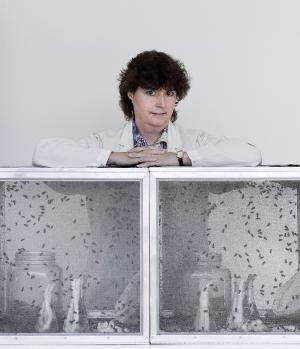Bodies at sea: Ocean oxygen levels may impact scavenger response

An ocean's oxygen levels may play a role in the impact of marine predators on bodies when they are immersed in the sea, according to Simon Fraser University researchers in a new study published this week in the journal PLoS One.
SFU criminologist Gail Anderson led the study, based on the deployment of a trio of pig carcasses into Saanich Inlet at a depth of 100 metres and studied over the past three years. Anderson assessed scavenger activity while co-author and SFU criminologist Lynne Bell continues her investigation of what happens to submerged bones.
The work is being conducted with the Victoria Experimental Network Under the Sea (VENUS), a cabled underwater laboratory allowing researchers to monitor their experiments and equipment via the internet. Numerous sensors recorded oxygen levels, temperature, pressure, salinity, density and other factors every minute. Anderson was able to control the camera from anywhere, including while at a conference in Mexico.
Researchers found that while the first two deployments were similar in nature in terms of scavenger response, with the carcasses reduced to skeletons within a month, the third remained in tact for months. Anderson says the big difference was in the dissolved oxygen levels.
"Saanich Inlet is hypoxic (deficient of oxygen) most of the year and anoxic (without oxygen) at some times," she explains. "While the animals there are adapted to low oxygen, the last carcass was deployed when it was extremely low, which kept out all the big scavengers such as the shrimp and Dungeness crab, leaving the squat lobsters, which were unable to break through the skin. This now gives us a better understanding of what happens to bodies in such waters."
Each of the carcasses was placed at the location by a remotely operated submarine with an underwater camera that was controlled by Anderson. Work is ongoing to remove the skeletal remains from these sea floor deployments.
The University of Victoria's VENUS platform used its sensors to continuously measure several other parameters that gave the researchers additional data, including water chemistry and physics details.
Anderson says this research allowed her to demonstrate earlier to the media and the public that feet naturally disarticulate. "So the so-called mystery of the 'floating feet' washing up on shores along the West Coast was not a mystery, but a natural occurrence in the marine environment," she says.
Anderson and Bell have just deployed the 10th set of pig carcasses in a marine setting—which are viewable by the public at venus.uvic.ca (see live viewing; note that the lights turn on every 15 minutes).
The Saanich Inlet location study was the first of a series of experiments, with carcasses so far having been deployed now in spring and fall in three different habitats and at three depths in the Salish Sea.
Anderson and Bell plan to next take the study much deeper into Barkley Canyon east of Vancouver Island. The work is part of Anderson's forensic investigative research that spans over two decades at SFU, and for the past three years, part of Bell's ongoing investigations into marine taphonomy.
More information: Anderson GS, Bell LS (2014) Deep Coastal Marine Taphonomy: Investigation into Carcass Decomposition in the Saanich Inlet, British Columbia Using a Baited Camera. PLoS ONE 9(10): e110710. DOI: 10.1371/journal.pone.0110710
Journal information: PLoS ONE
Provided by Simon Fraser University




















